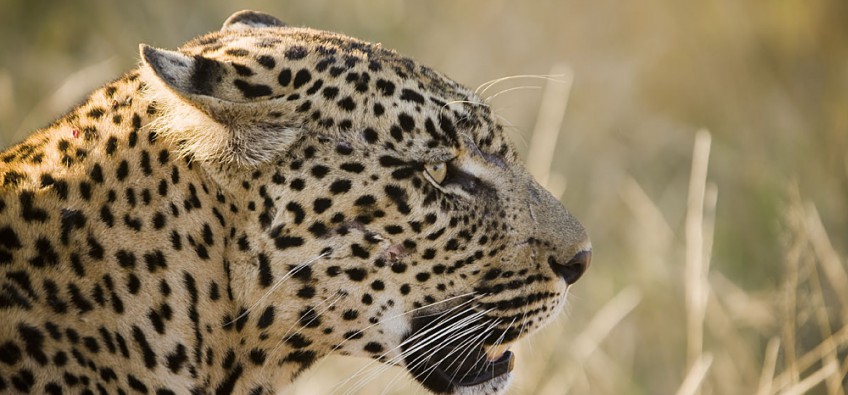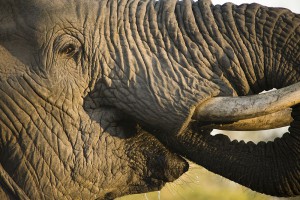On Safari Health and Safety is Exciting

Gordon Fuller FIIRSM explains how he managed the risk of man and beast in a modern day stand-off.
I am sitting in the passenger seat of an ISUZU 4 x 4 looking at a huge Elephant, she is the matriarch cow of the herd and weighs in at around 4 ton, Ears flapping wildly, she is stamping her front feet and levelling her 75lb ivory tusks for a potential broadside charge but already I know that this is just a warning to back off! An elephant will not charge while it’s still swinging its trunk unless of course it’s a mock charge and even that could be deadly if the Elephants distance judgement is slightly off. Just before the real charge comes the trunk will be carefully tucked away to protect it from impact. This Elephant is protecting young calves within the herd of around 15 cows and I have just noticed her second in command in the rear screen, it seems we are surrounded by large grey mammals who are not too overjoyed at our close encounter. It’s time to go but will the car start? If it does will it startle the herd causing a stampede capable of reshaping the Isuzu to resemble a beer mat?
You may perceive this as a seriously dangerous situation with high risk and severe outcome potential, and you would be correct but this is one example where all risk cannot be eliminated, in fact risk reduction methods have already been applied. The car is serviced and checked daily; drivers are competent not only in driving skills but also in animal behaviour, the guy behind the camera is not only one of the top professional photographers in South Africa but is also an accomplished zoologist, and that’s not just any camera!
Before the planned shoot takes place a great deal of ground work needs to be done, this includes tracking the selected herd and counting the number of cows and calves. This way we have an idea of how many there are and often a quick count can tell us that they are all in view and surprises from the bush are limited. This for many reasons isn’t fail proof as even Elephants can disappear and reappear from complete cover in seconds, it’s also possible that a bull Elephant or two may be tracking the herd or a cow having delivered a calf is re-joining the herd, there are so many factors contributing to the risk that constant states of vigilance and awareness are essential ingredients of the risk management process. In this work environment, there is little value in generic risk assessment and a two-yearly review, risk assessment is current and to call it dynamic simply underestimates the speed of changing circumstances.
Our professional photographer is none other than James Campbell of Creative Nature www.creativenature.co.za accomplished award winning wildlife photographer with an enviable reputation for up close wildlife action including the most dangerous species on earth. James’s amazing portfolio not only confirms his photography knowledge and experience but also highlights his incredible risk management skills.
I was privileged to join James on Safari in South Africa where I had the opportunity to test risk management skills, often to the extreme.
As a professional risk analyst employed by RCES (UK) Ltd www.rces-ltd.com it’s often difficult to find a real test of knowledge and skills, as a good risk management process is suitable to most industries with some small adaption for process and skill base, but wildlife photography certainly has a comprehensive range of hazards and varying degrees of risk, all of which are manageable to a degree. That is to say that one must be prepared to manage residual risk with swift decision making based on real knowledge and experience. You can read all the wildlife books you can find but none will provide a comprehensive safe system of work for close up shots of Lion, Buffalo or Hippopotamus, every great white hunter will have his own account of how he dodged being mauled or killed, some will tell you how they survived and some will tell you how their colleagues died at the hands of an angry beast, the circumstances always slightly if not drastically varied. I have very quickly come to the conclusion that wild animals do not read animal behaviour books.
Technical advances in photography equipment have certainly reduced risk by reducing the need to get so close on every occasion, it is however often the case that the closer the proximity to the animal the greater the value of the picture.
Understanding human behaviour has its limitations for the safety professional as an individual’s actions are not precisely predictable, although many qualifications will cover sociology, psychology and human behaviour, guidance notes for industry such as the HSG 48 provide good examples of past behaviour based safety in the context of human failure but do we do not always predict the person’s action prior to an event. In most work environments, we deal with human error on several levels being routine, situational and exceptional; these are viewed and understood as why a person carried out an unintentional act.
When dealing with wild animals we can of course relate to routine, situational and exceptional although the animal’s action must be viewed as intentional in each circumstance. In a situational condition say a bush fire, the animal takes action which must be viewed as situational intent based on survival, this may be partially predictable action, it becomes exceptional when the photographer places himself in the path of the animal in order to record that predictable action. In this instant, the animal’s intent is no longer completely predictable due to the exceptional circumstances it now finds itself in.
The final action of the animal in such circumstances cannot be described as exceptional error as it is intentional exceptional behaviour based on survival, arguably it may be situational error on the part of the photographer although he too intended his action to get the shot which is perceived to be exceptional, it was not an error but a planned option, an exceptional option!
Back at our favourite South African restaurant known simply as 278 on Main Street, www.278onmain.co.za Clarens in the Free State, the walls were decorated with James’s close encounters with varying wild animals of the African Bush, a pictorial diary of events which not only produces an amazing picture enhanced through professional photographic technique, but also told a story of risk management skill. When as I did, a person looks beyond the picture to how it was created, you might ask did anyone die getting this? You may also half expect an answer telling you it was done with telephoto lenses from half a mile away, but the truth is this is man and beast in a modern day stand-off.
The understanding on the part of the photographer and the tolerance of the animal subject are the sole ingredients of a risk management system which I felt required more in depth analysis. As a risk analyst, I ventured into the bush with James intent on applying my own standards of risk assessment, I was very quickly reminded of two basic skills, look and listen, which generally meant look at everything while listening to James. The impossibility of the situation was to give 100% attention to both senses and not to be diverted or distracted by either individually.
Here in the bush like most work environments we are surrounded by hazards (potential for harm) but here the level of risk (likelihood of actual harm being caused) can alter or be altered by other hazards which we describe as influencing factors. These can be wind direction, wind speed or simply wind existing at all. Work environments everywhere are subject to influencing factors which we refer to as Environmental, Human and occupational, now we must add animal and further develop the environmental understanding to cover all foreseeable conditions in light of the actual conditions or extended perceived conditions due to collective circumstances.
For example, when stalking white Rhinoceros, it pays to know something about the animal, the first thing is to be sure you have the correct species and to some people it may appear quite simple to identify a Rhino although the significant difference in black and white Rhino is essential understanding when dealing with risk management, sadly not such an issue now due to intense poaching over many years making both but especially the black rhino extremely rare and endangered.
It is also true to say that Creative nature wouldn’t sell a bundle of pictures if James didn’t know the difference between black and white Rhino, for me the significance is the fact that the white Rhino (wide mouth) has a larger heavier head and is a true grasser whereas the black Rhino with a more pointed mouth is a browser and a grasser. Both however do not have the most amazing eye sight and getting close to a white Rhino is relatively simple if the usual quite method of stalking is adopted as hearing will also not be the Rhinos leading sense, the animal is far more reliant on sense of smell, If the Rhino does manage to pick up your scent it will have little problem in instantly locating you and when, not if it does, you will need to break the world record in calculating Likelihood verses Severity equals Risk!
The black Rhino of course may have located you even sooner as whilst browsing it would have most probably have lifted its head allowing the scent to be detected earlier.
So what are the hazards in your risk assessment? Such titles as Rhino species, Consideration should also be given to wind speed, direction and also your scent, have you ever considered what you smell like and how strong the scent as an essential part of a risk assessment? In this case it could drastically change both likelihood and severity as the Rhino may instinctively become offensive or defensive based on type and strength of scent. If you wanted to get close to a wild animal would you really want to smell like something that makes it run away, of course not, but you also wouldn’t want it charge you either, but if your presence is detected the latter is definitely foreseeable, The Rhino may well be in open bushveld with little cover once you have decided to move in, consideration of the Rhino speed now becomes a real consideration although not for the Rhino.
A Rhino is not a carnivore and therefore is not used to seeing its food running away at speed, it doesn’t chase man in order to satisfy its appetite but in order to eliminate a threat to itself or more often its young, the word eliminate in this context should serve to focus the mind on real risk assessment and especially the outcome based on worst case scenario. If stalking a Lion, circumstances for determining risk level would differ enormously as that which runs away from a Lion is usually food, hazard identification and level of risk in this case may well be determined according to the quantity and time of the Lions previous meal in addition to other factors including gender, as a Lioness having made a recent kill may remain hungry due to the males feeding first, a small Impala is not likely to satisfy a whole pride leaving the Lioness ready to kill again almost immediately. Presence of young, mood, current pain levels and circumstances which may have interrupted sleep or mating are all factors worthy of consideration here.
Knowing what an animal is likely to do is important but remains fluid in many situations, knowing what an animal is capable of doing may be far more useful in assessing risk. Also understanding what it is that makes an animal react will often provide essential nano seconds to aid your own response time, an animal may not hear, see or smell your approach but will in some cases receive an external warning. A Buffalo if upwind engrossed in grassing with a large herd may not have detected a threat but could suddenly react to Ox Peckers, a small red billed bird that feeds on the ticks living on the Buffalo. The birds will quickly react to any threat by giving flight, this serves as a warning of danger to the animal on which they feed. A charge from a Buffalo however is more likely if it is injured and in pain although there are many reasons why such a creature may charge and some may remain unknown to man.
Having arrived in Africa armed with knowledge of the Management of Health and Safety at Work Regulations, regulation 3 and 4 along with its specific guidance and ACOP, 26 years experience in analysing risk and educated to MSc in risk management I soon found that there are several species that are far more experienced in risk assessment than man will ever be. We could learn not only how to calculate and manage risk of close encounters with wildlife but we could learn everyday risk management skills based on the study of instinct and survival that has developed over thousands of years.
During my to date, short lived experience of the bush and wildlife I have found myself studying several versions of animal behaviour from many perceptions including observers, great white hunters, traders, zoologists and more recently photographers. Many of the publications told of ancient and modern tails of how man and beast lived side by side although most ended tragically for man, it appears that it’s simply a question of tolerance for the animal, and when the risk is no longer tolerated it is eliminated, the question remains, what is it that makes a risk intolerable?
For man the answer is biased within individual perception and influencing factors, so a trade-off situation applies based on give and take. The photographer tolerates an accepted level of risk to be rewarded with the photograph, but why does the animal tolerate the risk and what if any is the trade off?
To further my knowledge of Safari Safety and the risk to the wildlife photographer I will be joining James Campbell of Creative Nature in South Africa in 2017 to hopefully discover and analyse the risk of tracking on foot, some of the most dangerous animal species that roam the bush.


